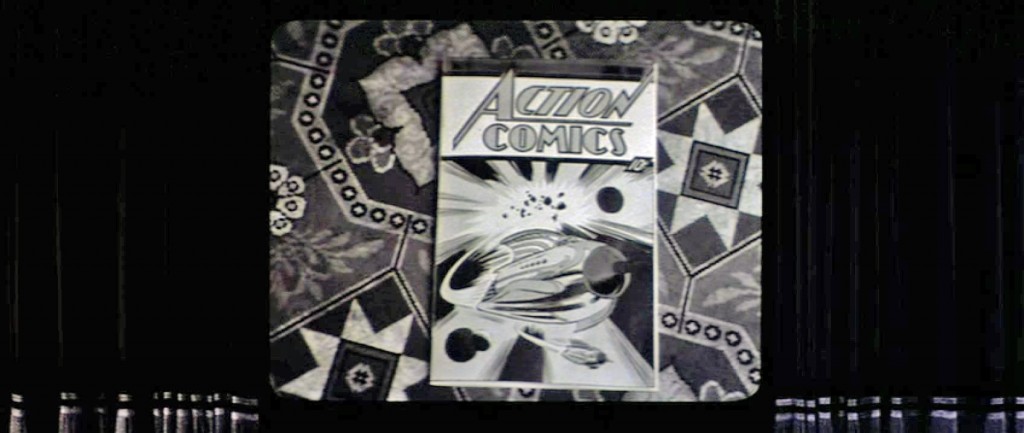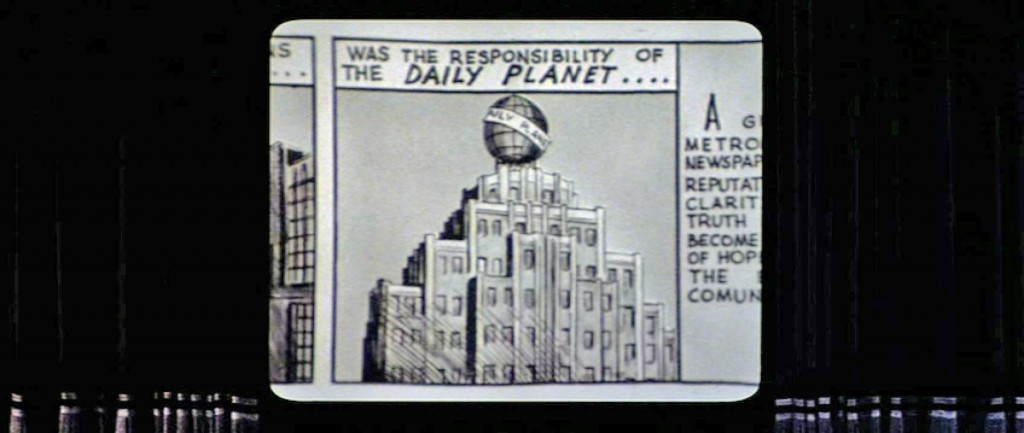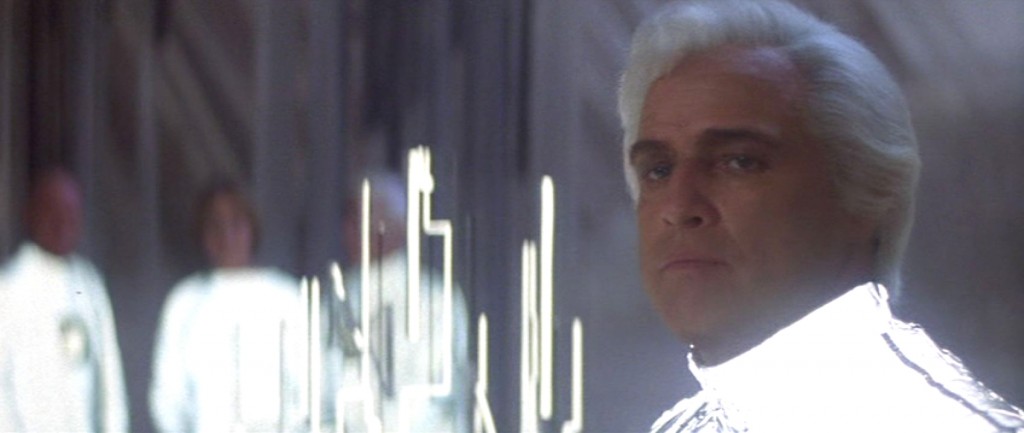Superman: Superman: The Movie part 1
The thing to remember about Superman: The Movie is that it was the first of its kind. Made in 1978 by middle-aged men, it was poised between nostalgia and hipness, gravity and camp, cutting-edge verisimilitude and old-fashioned Hollywood spectacle. It wants to take its subject matter seriously, but can’t quite commit to it fully.
I was 17 when it came out, and theoretically its target audience. The advertising, John Williams score and space-bound title sequence made it clear that it was going after the Star Wars audience, which included children who didn’t know about Buck Rogers serials and nostalgic grownups who did. Having never read the comics, my concept of Superman in 1978 was limited to the syndicated reruns of the George Reeves show from the 1950s (which had borrowed heavily from the radio shows of the 1940s). The stunning Fleischer Superman shorts were a long-gone artifact at that point, not yet available at the counters of every drugstore in America. Only one, “Superman and the Mechanical Monsters,” had been shown to American audiences in recent decades, in the 1977 Fantastic Animation Festival, which was, in and of itself, a cultural touchstone in the pre-cable days of American geekdom.
The George Reeves show never went to Krypton or dwelled on Superman’s tragic backstory (much as the 1966 Batman show never once mentioned why Bruce Wayne dresses up as a bat to fight crime), so the idea of a movie presenting, with grandeur, “serious” actors, a large budget and state-of-the-art special effects (that look laughably terrible today) was breaking new ground for a viewer like me. And the first couple of acts really hammered home the weighty mythology and came to form the idea of Superman in the minds of my generation.
So the movie opens with a shot of curtains opening to reveal a 1930s movie screen, with standard 1:33 aspect ratio. The curtains, in an of themselves, were significant in 1978 because that was the moment that multiplexes were exploding, and curtains in movie theaters were becoming a thing of the past. The curtains in the movie palace were there to remind the audience of the ritual of the theater, of the glamour that awaited the audience on the other side of those curtains – the multiplex did away with glamour and ritual. They turned moviegoing into a transaction, not a passport to adventure. By opening with a shot of curtains, black-and-white curtains at that, the movie seeks to frame its presentation in a sense of tradition, of promises made and kept.
(The theater where I saw Superman was, in fact, a converted vaudeville house from the 1920s, complete with stage, dressing rooms, orchestra pit and fake “Spanish Piazza” decor. When the curtains opened to reveal a movie that begins with curtains opening, it made the moment doubly somber.)
The movie-within-the-movie that shows on that 1930s screen, oddly enough, is of a comic book: Action Comics (why they didn’t choose Action Comics #1, with its now-classic cover, is beyond me, except that the rocket-ship cover they’ve mocked up keeps their “star” under wraps for a while). Who would go to see a movie that does nothing but show a comic book? Again, the answer lies in nostalgia: the boy’s hand seen turning the pages of the comic book belong to the movie’s producers, the middle-aged men who decided to take this bold step. They wanted to recapture the wonder and glory of a hero as they remembered seeing him through the eyes of a child. Being released on the 40th anniversary of Action Comics #1, the black-and-white comic book opening also invites the audience to remember that Superman is part of a tradition, that he represents something deep in the American character, something both very innocent and very powerful.
What does the opening pre-titles movie want to tell us? Not that there is a strange being from another planet with magic powers, but that there was a newspaper, right here on Earth, in the city of Metropolis, called the Daily Planet, and that the Daily Planet was a key component of its Depression-ridden society: it brought the population “clarity, truth and hope” in a dark and confusing time. And then the screen goes wavy and the titles start, with no mention of Superman, Krypton, or anything else.
What does this mean? Why does a movie called Superman use up valuable real-estate by talking about the Daily Planet, as it was in the 1930s? The movie takes place today, what does the Depression have to do with anything? Obviously, the movie wants to make a connection between 1938, with its miserable economy and the storm-clouds on the horizon, and 1978, with its corrupt politicians, rampant drug use, mainstream pornography and Carter-era malaise. All the President’s Men had revived the notion of a journalist hero. As it was, so it is, the movie says, “We are a society in crisis and are in need of a hero.”
Once the Star Wars meets 2001 titles are over, we are set down on the planet Krypton, where we meet Jor-El, who is, apparently, something like a prosecuting attorney in a Kryptonian high court. The criminals he’s prosecuting, General Zod and company, have no narrative impact until Superman II, so again, there is a mysterious prologue where there should be narrative. If the sentencing of General Zod has no bearing on the present story, why is it in the movie? Well, it certainly presents Jor-El as a serious figure (played by living-legend Marlon Brando, no less), an incorruptible man who has to deal with weighty matters like the punishment of traitors. “Responsibility,” and its cohabiter “power,” those watchwords of all superhero narratives, are thus insinuated into the Superman narrative early on, before the protagonist has even appeared.
Jor-El has the power to send traitors into the Phantom Zone (which, in this movie, is a large flying record sleeve), but he is apparently an unpopular member of the Kryptonian Council of Nabobs, and once Zod is disposed of, the real narrative of Superman begins. Jor-El insists that the planet will explode in 30 days (strange that he would concern himself with a treason trial for a planet that’s not going to exist in a month’s time) and the rest of the council politely suggests that he’s losing his mind. So, we have a planet where traitors are sentenced to float endlessly through the universe and the high council refuses to listen to science. What’s more, they threaten Jor-El with his own charges of treason if he goes around spreading the idea of imminent doom, effectively “silencing the press” (which brings us back to the pre-titles precis). Is Krypton, it’s worth asking, worth saving? It’s certainly no utopia – it’s a dark, chilly, sterile ice-planet with underground cities and an authoritarian regime.
Jor-El does the reasonable thing and puts his newborn son Kal-El into a chandelier and send him to Earth. Why Earth? asks his wife, who, all things considered, takes the plan in relative stride. Jor-El’s answer: because they’re so primitive, their son will have all possible advantages. Jor-El, it seems, wants his son to be considered a kind of god, while his mother is worried that he won’t be popular, that he’ll be an outcast. Coming from the Kryptonian background as presented here, it seems to me that reviled-outcast + sense of superiority = vengeful overlord, a superman in the Nietzschean sense. Whatever Jor-El’s intent, fate will intervene to produce something else.
I’m not sure why Jor-El doesn’t make a chandelier big enough for the whole family to escape the doomed Krypton (or “Kriptin” as Brando pronounces it). I know it’s probably in the backstory somewhere, but as far as this screenplay goes it’s just that Jor-El builds a chandelier and puts the baby inside it and sends it off. The implication is that this was a last-ditch plan after the Council turned down his evacuation plan, but wait: if he only had time to build one chandelier big enough for a baby, what did he expect the rest of Krypton to put together in 30 days to evacuate the entire planet? For that matter, how common is it that Kryptonian lawyers also build interplanetary spaceships in their rumpus rooms?
The answer to all this is, of course, that none of it matters, it’s all narrative shorthand. The fate of Kal-El isn’t meant to be taken literally, it’s a metaphor for something much older. Kal-El is Moses in the basket, set into the river by parents who want better for him. Moses becomes an Egyptian prince with great power and wealth, which he then uses to free his people, but the Jews of the 20th century didn’t have an Egypt to send their children to, they had the United States, a land as foreign as a distant star, where, yes, their children would be scorned as outcasts. And, of course, the Jews who sent their children to the US often didn’t have a people left to free by the time their children had grown. Whether Superman is specifically meant to be a krypto-Jew or not, the immigrant experience defines America, and it’s that tradition, that deep racial memory, that Superman intends to evoke.



I think Superman canon holds Jor-El was working on a larger spacecraft, but Krypton blew up ahead of his calculations, so they had to send Kal-El away in a small prototype space ship.
A deleted scene includes a sinister Kryptonian guard:
http://www.youtube.com/watch?v=f1TFD0nFhXA
Todd, are you planning on analyzing just this movie, or multiple Superman movies a la your Batman series? If the latter, you might find the ‘All-Star Superman’ animated movie interesting. It’s based on an acclaimed comic book series from 2005-2008 in which Superman learns that he’s dying from an overdose of solar radiation, which changes his perspective on his relationship with Lois Lane, Lex Luthor, mankind, etc. (It’s kind of an “outside of continuity” storyline.)
Geez, that Kryptonian Council is a bunch of jerks. I’m glad their planet blew up.
I’m going to analzye the theatrical features, I can’t get into the comics’ adapatations. Not for lack of desire, but for the sake of time.
I’d read over and over again that that run of All-Star Superman was excellent, so I just bought it the other day. I’m sorry to say I found it to be quite disappointing.
Well, I’m excited. I can’t wait to read your commentary on Supermans I & II. And I’m glad someone is pointing out Superman’s similarity to the Moses story, rather than Jeebus.
Apollo. I’d take a Superman-as-Apollo before Superman-as-Jeebus.
Originally, Superman was Moses, but in this movie Superman is Jesus, which means that Jor-El is God and Krypton is Heaven. The first thing we see Jor-El do is cast rebels into a plane of torment. But because this movie is about divinity vs. humanity, we get a kind of shitty heaven.
I was just thinking about how, in keeping with the krypto-Jew message, Krypton is a place like (as Jules Feiffer said) Poland, where Jor-El was still a Jew among Poles, ostracized and outcast.
I could swear there was an episode of BATMAN where Bruce Wayne actually states he won’t touch a gun because of what happened to his parents.
This interpretation of Krypton very much informed the Post-Crisis John Byrne reboot for DC.
(And it’s the Phantom Zone, not the Forbidden Zone.)
D’oh!
Speaking of the Forbidden Zone, have you considered doing an analysis of the Planet of the Apes movies?
I haven’t! But I actually bought a boxed set of them a while back, maybe I should.
I do hope these analyses include the newly-released MAN OF STEEL, because after Donner’s SUPERMAN, I think it’s the one that would benefit the most from serious discussion.
It wants to take its subject matter seriously, but can’t quite commit to it fully.
As was true of most fantasy movies prior to the last, what, fifteen years or so? A fact I partially chalk up to the problems with special effects: if your fantasy stuff looks goofy, there’s a strong temptation to hold back, to laugh at yourself before other people can do so. Once it starts looking real enough, though, it’s easier to commit.
(Commenting belatedly because I was out of town.)
I think that’s part of it, but also, the fantasy audience simply came of age. The generation of teenagers who soaked up Star Wars grew up to make their own movies. The guys who made Superman, for better or worse, still had roots in Old Hollywood, the people for whom “serious film” was Truffaut, not Lucas, and for whom “big” meant Ben-Hur, not The Dark Knight. In a way it says a lot about our society that our big-budget, “serious” spectacles are now based on comic books instead of the Bible, but those movies were just as dumb as anything made today.
“made it clear that it was going after the Star Wars audience” Considering Superman The Movie was made AND in theatres just as Star Wars was hitting its popular stride, the movie WAS not ‘going after’. Donner didn’t have any idea Star Wars was being made nor that it would be the hit we all know now. The films were being made at the same time. Enough of this “cashing in” mentality… Superman The Movie stands alone !
Superman: The Movie was released at the end of 1978, a year and a half after the first Star Wars movie. That gave the filmmakers plenty of time to gear their promotional efforts toward the Star Wars audience.